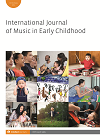-
f Children’s concerts: Experiences of university music students and faculty
- Source: International Journal of Music in Early Childhood, Volume 14, Issue 1, Jun 2019, p. 111 - 126
-
- 01 Jun 2019
Abstract
This article describes perspectives of university music students and faculty who prepared and facilitated a concert series for young children and their caregivers. We include an introduction to literature regarding listening behaviours of young children and live music experiences specifically designed for young children. We describe the children’s concert series created by music students and faculty at a university in the United States and focus on reflections of the music students and university faculty who prepared and facilitated the concert series. Included are descriptions of benefits and challenges experienced by music students and faculty and staff responsible for creating and administering the concerts. We suggest strategies for developing and facilitating such concerts and suggest avenues for future research related to community engagement via children’s concerts. While these concerts were intended to benefit children in the audience, descriptions of specific benefits for the children are beyond the scope of this article.


